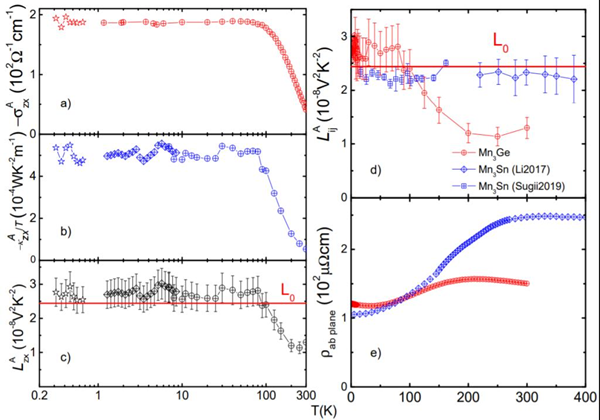On April 24, Science Advances published online an article entitledFinite-temperature violation of the anomalous transverse Wiedemann-Franz lawby Professor Zhu Zengwei of Wuhan National High Magnetic Field Center (WHMFC). Huazhong University of Science and Technology (HUST) is the first author affiliation. Professor Zhu Zengwei, HUST high-end foreign expert Professor Kamran Behnia and Professor Yan Binghai of Weizmann Institute of Science in Israel are the co-corresponding authors of the paper. Xu Liangcai, a PhD student of the class of 2017 from the Center, is the first author. PhD student Li Xiaokang and engineer Lu Xiufang participated in the relevant work.
In the movement of metal materials, electrons can conduct both current and heat flow, which satisfies Wiedemann-Franz (WF) law, namely, Lorentz constant = conductivity / (thermal conductivity╳temperature) = Sommerfeld value (L0=2.44 × 10-8V2K-2). This law has been verified in a large number of materials. If an external magnetic field is applied to the material, the moving electrons will deflect under the action of the Lorentz force, resulting in a transverse voltage and temperature difference proportional to the magnitude of the external magnetic field. This phenomenon is called Hall effect and thermal Hall effect. Further research shows that the intensity of Hall effect in magnetic materials is not proportional to the size of external magnetic field. Recent theoretical studies suggest that the anomalous Hall effect is determined by the Berry curvature of the electron energy band, which has been verified by Zhu Zengwei's team in the prior study on the anomalous transverse WF Law study of the noncolinear antiferromagnetMn3Sn(Phys. Rev.lett. 119, 056601, 2017).

Fig. 1Anomalous transverse WF law
The finite-temperature violation of the WF correlation.
Through the study of anomalous Hall effect and thermal Hall effect of noncollinear antiferromagnetMn3Geextended from room temperature down to sub-kelvin temperature (Fig. 1), it is verified that the anomalous transverse WF law is also valid at low temperatures, but not at high temperatures.

Fig. 2 Pondering functions for transport coefficients
(A)The pondering functions for electric (∂f(ϵk)/∂ϵk), thermoelectric ([(ϵk− μ)/kBT]∂f(ϵk)/∂ϵk), and thermal ([(ϵk− μ)/kBT]2∂f(ϵk)/∂ϵk) transport (49,51,52).
(B) A representation of how a mismatch between thermal and electrical summations of the Berry curvature can occur if the two pondering functions do not average the overall contribution of the Berry curvature sources and sinks.
In general, inelastic scattering of electron-phonon in materials deviates from the WF law. However, through comparative analysis withMn3Sn, it is found that the deviation of WF law inMn3Gedoes not conform to the traditional scattering mechanism. To explain this phenomenon, a new mechanism is proposed based on theBoltzmann transport equation: In the semiclassic transport theory, both thermal and electrical conductivities are the integration of a specific distribution function and Berry curvature on the Fermi surface. The difference is that the distribution function of electrical conductivity is a unimodal function, while the distribution function of thermal conductivity is a bimodal function (Fig.2A). With the increase of temperature, the thermal De Broglie length of the electron changes, resulting in the mismatch between the integration results of thermal conductivity and electrical conductivity with the Berry curvature, thus breaking the anomalous WF law (Fig. 2B). At the same time, the study also reveals a competition between the temperature and the Berry curvature distribution through theoretical calculation, thereby verifying the above model. The results also show that the anomalous WF law can sensitively probe the Berry curvature near the Fermi energy.
The research is supported by National Key R & D Program of China, National Natural Science Foundation of China, and High-end Foreign Expert Program of HUST.
Paper link: https://advances.sciencemag.org/content/6/17/eaaz3522